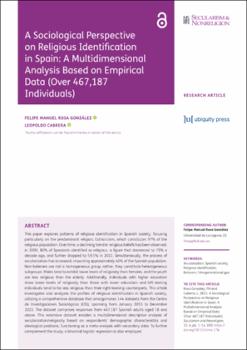A sociological perspective on religious identification in Spain: a multidimensional analysis based on empirical data (over 467,187 Individuals)
Fecha
2023Resumen
This paper explores patterns of religious identification in Spanish society, focusing particularly on the predominant religion, Catholicism, which constitutes 97% of the religious population. Over time, a declining trend in religious beliefs has been observed: in 2000, 80% of Spaniards identified as religious, a figure that decreased to 75% a decade ago, and further dropped to 59.5% in 2022. Simultaneously, the process of secularization has increased, impacting approximately 40% of the Spanish population. Non-believers are not a homogeneous group; rather, they constitute heterogeneous subgroups. Males tend to exhibit lower levels of religiosity than females, and the youth are less religious than the elderly. Additionally, individuals with higher education show lower levels of religiosity than those with lower education and left-leaning individuals tend to be less religious than their right-leaning counterparts. This article investigates and analyzes the profiles of religious identification in Spanish society, utilizing a comprehensive database that amalgamates 144 datasets from the Centro de Investigaciones Sociológicas (CIS), spanning from January 2013 to December 2023. The dataset comprises responses from 467,187 Spanish adults aged 18 and above. This extensive dataset enables a multidimensional descriptive analysis of secularization/religiosity based on respondents' demographic characteristics and ideological positions, functioning as a meta-analysis with secondary data. To further complement the study, a binomial logistic regression is also employed.






